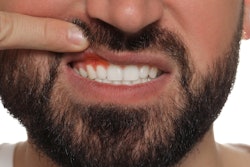
Alone and together, lifestyle factors like smoking, excessive drinking, and depression may significantly affect the risk of developing periodontitis, according to a study published on May 6 in BMC Oral Health.
Among people with depression, smoking significantly may raise the likelihood of periodontitis. Additionally, when smoking and heavy alcohol consumption co-occur, there may be a considerable increase in periodontitis prevalence, according to the study.
"There were interactive effects between smoking, drinking and depression on periodontitis risk and policies aimed at healthy behaviours and mental health may be beneficial for our oral health,” wrote the authors, led by Y.Q. Huang of the Shanghai Jiao Tong University School of Medicine School in China.
The study examined the data of 6,816 individuals who took part in the U.S. National Health and Nutrition Examination Survey from 2009 to 2014. Participants underwent assessments for oral health, including periodontal examination, and provided information through questionnaires on smoking, alcohol use, and general health.
Periodontitis was identified by a clinical attachment loss of 3 mm or more, while depression was assessed using the Patient Health Questionnaire-9, with scores of 10 or higher. Alcohol consumption was categorized as low (one drink or less), moderate (one to three drinks), or heavy (four drinks or more) based on daily intake over the past year. Smoking was defined as having smoked at least 100 cigarettes in one's lifetime.
Of the participants, about half were current or former smokers, about 15% were low drinkers, about 70% were moderate drinkers, and 15% were heavy drinkers. Of the total population, the prevalence of periodontitis was about 39% and depression was about 8%.
Logistic regression, along with interaction models, was used to assess how smoking, drinking, and depression individually and together affected the risk of periodontitis, according to the study.
The findings showed a significant interaction between smoking and depression, indicating that their combined effect increased the risk of periodontitis, particularly among males. Among people with depression, smoking significantly raised the likelihood of periodontitis by 1.29 times in younger individuals compared to nonsmokers (odds ratio [OR], 2.29; 95% confidence interval [CI], 1.10 to 4.76), they wrote.
Also, there was a dose-dependent association between drinking frequency and smoking on the incidence of gum disease. In those who smoked, occasional drinking (OR, 1.70; 95% CI, 1.22 to 2.37) and regular drinking (OR, 2.28; 95% CI, 1.68 to 3.11) dramatically elevated the prevalence of periodontitis for these participants.
However, the study had limitations. The study was cross-sectional, so it may not establish causality or the sequence of events between long-term factors like periodontitis and smoking and short-term ones like drinking and depression, they wrote.
"In summary, there was a significant multiplicative interaction between smoking-depression and smoking-drinking, and promoting healthy behaviors and mental well-being may play a crucial role in the prevention of periodontitis," Huang et al concluded.



















